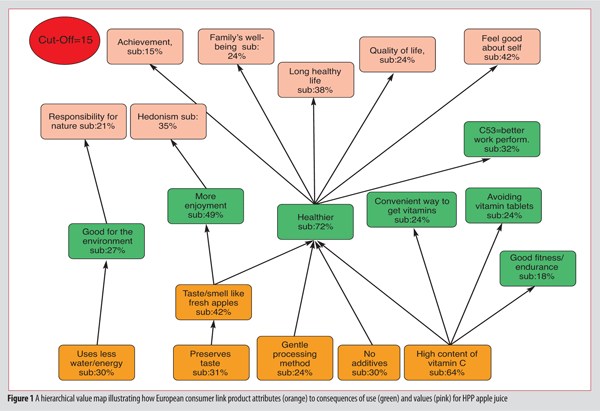High-Pressure and Pulsed Electric Field: What do the consumers think?
- Like
- Digg
- Del
- Tumblr
- VKontakte
- Buffer
- Love This
- Odnoklassniki
- Meneame
- Blogger
- Amazon
- Yahoo Mail
- Gmail
- AOL
- Newsvine
- HackerNews
- Evernote
- MySpace
- Mail.ru
- Viadeo
- Line
- Comments
- Yummly
- SMS
- Viber
- Telegram
- Subscribe
- Skype
- Facebook Messenger
- Kakao
- LiveJournal
- Yammer
- Edgar
- Fintel
- Mix
- Instapaper
- Copy Link
Posted: 12 May 2010 | Nina Veflen Olsen (Nofima Mat) and Anne-Mette Sonne (MAPP) | No comments yet
New products and processing techniques are continuously being developed within the food industry. While food scientists may focus on the technical novelty and applaud the progress of science, consumers are often more conservative and sceptical about changes. From earlier experiences with gene modification and irradiation, we have learnt that advantages that new processing technologies offer do not guarantee the success of a product in the market place. Consumer acceptance depends on whether they perceive specific benefits associated with the product,1,2 which means identifying factors that influence consumer acceptance is important.
New products and processing techniques are continuously being developed within the food industry. While food scientists may focus on the technical novelty and applaud the progress of science, consumers are often more conservative and sceptical about changes. From earlier experiences with gene modification and irradiation, we have learnt that advantages that new processing technologies offer do not guarantee the success of a product in the market place. Consumer acceptance depends on whether they perceive specific benefits associated with the product,1,2 which means identifying factors that influence consumer acceptance is important.
New products and processing techniques are continuously being developed within the food industry. While food scientists may focus on the technical novelty and applaud the progress of science, consumers are often more conservative and sceptical about changes. From earlier experiences with gene modification and irradiation, we have learnt that advantages that new processing technologies offer do not guarantee the success of a product in the market place. Consumer acceptance depends on whether they perceive specific benefits associated with the product,1,2 which means identifying factors that influence consumer acceptance is important.
Within NovelQ (see www.novelQ.org for more information), consumer acceptance of novel foods has been investigated. Conventional processing techniques such as pasteurisation lose the fresh characteristics associated with the raw ingredients of plant origin (taste, aroma, texture, healthy ingredients). New treatments, which extend shelf-life without compromising these attributes, are therefore desirable. Two such treatments are High Pressure Processing (HPP) and Pulsed Electric Fields (PEF). Whether consumers will accept food processed using these novel technologies has been investigated within NovelQ. Consumers’ acceptance of apple juice treated with PEF and HPP was compared with their view of pasteurised and fresh apple juices in four European countries: Norway, Denmark, Hungary and Slovakia, using three methods: 1) focus group analysis, 2) MEC-analysis and 3) Conjoint analysis.
Advantages and disadvantages
The main advantages of HPP and PEF treated products were perceived to be the naturalness, improved taste and high nutritional value. A lack of information about these technologies was regarded as the major disadvantage. With respect to the PEF and HPP processes, the participants deemed environmental friendliness and a more natural product as the main advantages whilst concern for body and health, higher cost and a lack of information about the technologies as well as a general scepticism were the main disadvantages. In a potential buying situation, the participants said that quality and taste especially play a critical role in accepting and maintaining the commercial marketability of these novel products. One participant said: “I don’t care too much about the method. I am interested in quality, i.e. smell and taste,” (Female, 50 years old, juice, Eastern Europe). This emphasises the importance of making consumer experience of products easy to develop a preference for PEF and HPP treated products. This could be realised by means of introductory offers or allowing consumers to sample the products in shops and other locations.
A comparison of focus group data led to the conclusion that many Northern European consumers view longer shelf-life as a negative attribute for PEF and HPP products, compared with freshly-squeezed juices, as longer shelf-life is believed to be less fresh. As one of the goals of developing the PEF and HPP technologies is to extend shelf life, this is a very interesting result. It shows that what is in the interest of food producers and retailers is not always in the interest of consumers. Thus, it might be important for food producers to apply PEF and HPP to products where currently a high level of processing damages the sensory characteristics: there is most to be gained by using PEF or HPP for highly processed products.
Information needed
Consumers recognise and appreciate the benefits that HPP and PEF have to offer when information is provided on the product label. This corresponds with a Brazilian study examining consumer acceptance of HPP juice3, which found that including the advantages on the labels enhanced consumer understanding and ‘intention to buy’ compared with simply naming the technology (i.e. HPP-treated). The importance of consumers recognising the advantages of HPP and PEF treated products was also determined in a European study that interviewed 3,000 adults4. The study found that 67 per cent of participants accepted HPP and concluded that consumers are ready to buy HPP, which have clear advantages.
Providing consumers with more information about the technologies seems key to achieving consumer acceptance, particularly in the case of PEF because many consumers associate the name with electricity and are sceptical about the side effects, which is illustrated by a remark from one of the focus groups: “I just cannot imagine this high voltage. I’m afraid of it. It sounds bad. Electricity is not for me,” (Female 29 years old, juice, Hungary).
An additional explanation for respondents’ reservations about PEF treated juices is perhaps that when faced with a choice between PEF and HPP, people opt for HPP treated juice because it is perceived as offering the same benefits as PEF whilst carrying less risk. Hence, it is the responsibility of manufacturers, retailers and food scientists to provide evidence that this technology is safe to use in connection with food processing. Ideally, such information should be provided early in the introduction of new technologies; research on GMO acceptance showed that information may reinforce negative responses once attitudes have become more stable5.
Consumer segments
Generally, consumers in Norway, Denmark, Hungary and Slovakia perceived PEF and HPP treated juices to be a better choice than pasteurised products, if the price and taste were right. For the most part, consumers want freshly produced apple juice with a premium taste at an affordable price. However, the finding that HPP juice is more acceptable than PEF juice is in line with previous studies6. In spite of these general tendencies, different segments co-exist.
The benevolence segment and the hedonic segment focus on different aspects when choosing apple juice. Consumers who perceive benevolence to be an important value stress both health and environmental consequences whilst hedonic consumers emphasise taste primarily. The benevolence segment, those who are concerned about the responsibility for other people, family’s well being etc., are likely to prefer fresh or HPP/ PEF juices rather than pasteurised products since these represent both more healthy and environmentally-friendly goods. The hedonism segment, emphasising pleasure, fun, enjoying life etc., choose apple juice with a good taste, independent of processing treatment.
As for the consumer preferences across Europe, some interesting differences between Northern and Eastern Europe were revealed. First, environmental concerns in Northern Europe (Norway) differ from those expressed in Eastern Europe (Hungary). Norwegian consumers were negative about pasteurised juices and positive concerning fresh juices; Hungarians were negative about HPP and PEF treated juices. Another further distinction was associated with health concerns. In Eastern Europe (Hungary and Slovakia), our results indicate that consumers are more negative towards pasteurised juice, which was not the case for the health-conscious consumers in Northern Europe. The latter group also seems to be more positive about premium priced apple juice than health-conscious consumers from Eastern Europe, who were much more price-sensitive.
Conclusion
Results from our consumer investigation have practical implications for the food industry. Firstly, that the European consumer perceives HPP and PEF treated juices to be a good alternative to pasteurised juice is good news for European juice producers. If they are able to produce premium juice for a standard price, there appears to be a market for such products. Secondly, consumers recognise and appreciate the benefits that food products produced using HPP and PEF have to offer when this information is provided on the product label. However, it is important to tailor HPP and PEF information to different segments; some are triggered by health and environmental concerns whilst others are attracted by improved taste.


References
- Frewer, L.J., Howards, C., Shepherd, R. (1996). The influence of realistic product exposure on attitudes towards genetic engineering of food. Food Quality and Preference, 7, 61-67.
- Frewer, L.J., Howard, C., Hedderley, D., Shepherd, R. (1997). Consumer attitudes towards different food-processing technologies used in cheese production – the influence on consumer benefit. Food Quality and Preference, 8, 271-280.
- Deliza, R., Rosenthal, A., Abadio, F.B.D., Silva, Carlos H. O. & Castillo, C. (2005). Application of high pressure technology in the fruit juice processing: benefits perceived by consumers. Journal of Food Engineering, 67, 241-246.
- Scholderer, J., & Frewer, L. (2003). The biotechnology communication paradox: Experimental evidence and the need for a new strategy. Journal of Consumer Policy, 26, 125-157.
- Butz, P., Needs, E.C., Baron, A., Bayer, O., Geisel, B. Gupta, B., Oltersdorf, U., Tauscher, B. (2003). Consumer attitudes to high pressure food processing. Food, Agriculture & Environment, 1 (1), 30-34.







